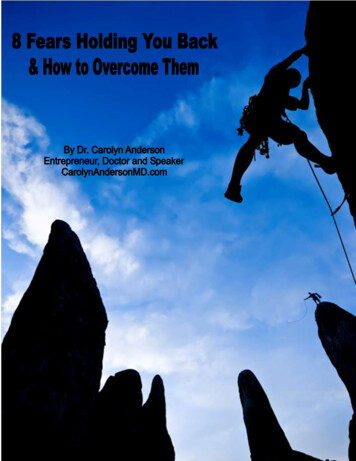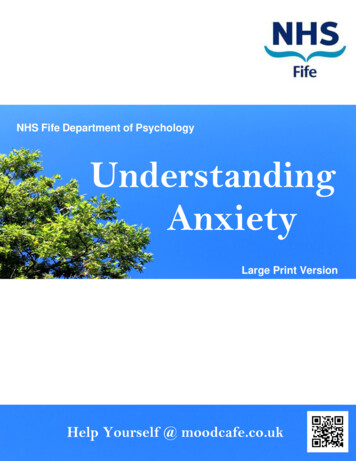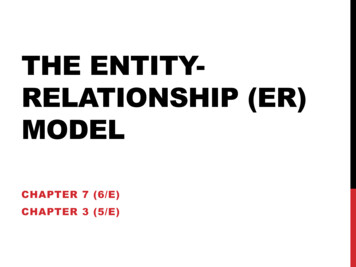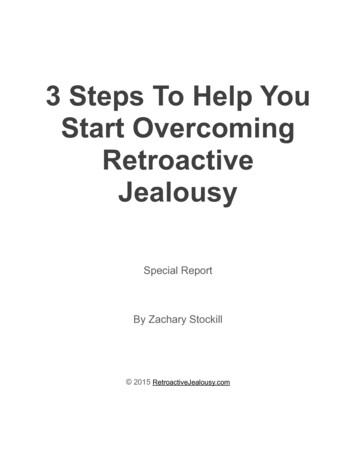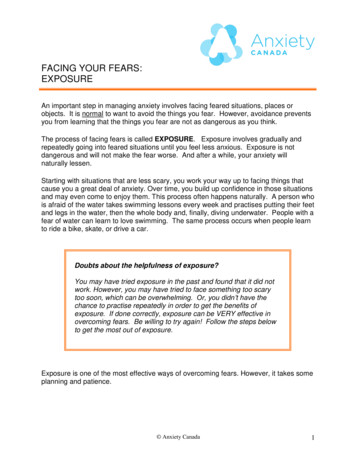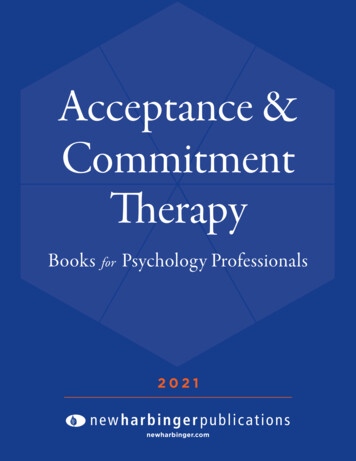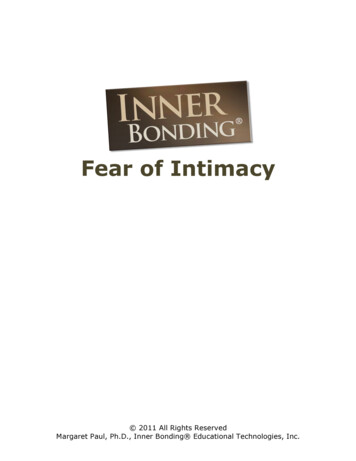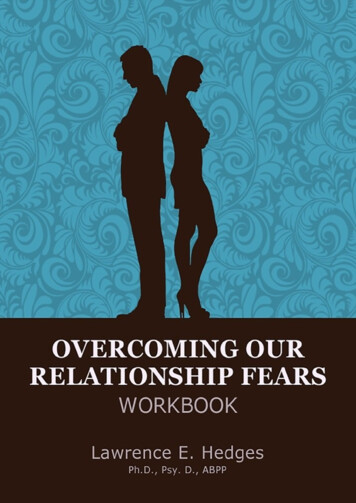
Transcription
Overcoming Our Relationship FearsWorkbookA Guide for Overcoming the SevenDeadly FearsLawrence E. Hedges
About the AuthorLawrence E. Hedges, Ph.D., Psy.D., ABPP is apsychologist-psychoanalyst in private practice in otherapists and psychoanalysts. He is director ofthe Listening Perspectives Study Center and the foundingdirector of the Newport Psychoanalytic Institute inTustin, California where he is a supervising and trainingpsychoanalyst. He is an Assistant Professor at TheUniversity of California Irvine Medical School, theDepartment of Psychiatry. Dr. Hedges is author ofnumerous papers and books on the practice spectives in Psychotherapy; Facing the Challenge ofLiability in Psychotherapy: Practicing Defensively andSex in Psychotherapy: Sexuality, Passion, Love and Desire in the Therapeutic Encounter. In addition, Dr.Hedges offers live video and book based Continuing Education courses for mental health professionals basedon many of his books; to learn more visit sfrankelgroup.com.Photograph courtesy Gale Rapallo
Copyright 2013 Lawrence E. HedgesAll Rights ReservedThis e-book contains material protected under International and Federal Copyright Laws and Treaties.This e-book is intended for personal use only. Any unauthorized reprint or use of this material isprohibited. No part of this book may be used in any commercial manner without express permissionof the author. Scholarly use of quotations must have proper attribution to the published work. Thiswork may not be deconstructed, reverse engineered or reproduced in any other format. The entire ebook in its original form may be shared with other users.Created in the United States of AmericaFor information regarding this book, contact the publisher:International Psychotherapy Institute E-Books301-215-73776612 Kennedy DriveChevy Chase, MD ipi.org
Table of ContentsAbout the AuthorIntroductionIdentifying and Managing Your Relationship FearsChapter OneHow the Seven Deadly Fears Operate in Your Close RelationshipsSummary Chart:The Seven Deadly FearsChapter TwoShrinking the Fear MonstersFocus the FearBreathe Deeply and Feel the ConstrictionsWrite in Your Aliveness JournalExperience the Body-Mind-Relationship ConnectionHandle Your Anxiety While Dealing With FearsFind a Listening PartnerThe "Shrink the Monster" ExerciseFind a New WayTwo Additional Daily ExercisesChapter ThreeThe First Deadly Fear:The Fear of Being AloneWhat the Fear of Being Alone is AboutHow the Fear of Being Alone BeganHow the Fear of Being Alone Works in Our LivesWorking With Your Fear of Being Alone
Focus the Fear of Being AloneElaborate in Your Aliveness JournalExperience the Body-Mind-Relationship ConnectionShrink the MonsterFind A New WayChapter FourThe Second Deadly Fear: The Fear of ConnectingWhat the Fear of Connecting is AboutHow the Fear of Connecting BeganHow the Fear of Connecting Works in Our LivesWorking With Your Fear of ConnectingFocus the Fear of ConnectingExperience the Body-Mind-Relationship ConnectionShrink the Fear of Connecting MonsterFind a New WayChapter FiveThe Third Deadly Fear: The Fear of Being AbandonedWhat the Fear of Being Abandoned is AboutHow the Fear of Being Abandoned BeganHow the Fear of Being Abandoned Works in Our LivesWorking With Your Fear of AbandonmentFocus the Fear of AbandonmentExperience the Body-Mind-Relationship ConnectionShrink the MonsterFind a New WayChapter Six
The Fourth Deadly Fear: The Fear of Self-AssertionWhat the Fear of Self-Assertion is AboutHow the Fear of Self-Assertion BeganHow the Fear of Self-Assertion Works in Our LivesWorking With Your Fear of Self-AssertionFocus the Fear of Self-AssertionExperience the Body-Mind-Relationship ConnectionShrink the MonsterFind A New WayChapter SevenThe Fifth Deadly Fear: The Fear of Not Being RecognizedWhat The Fear of Not Being Recognized is AboutHow The Fear of Not Being Recognized BeganHow The Fear of Not Being Recognized Works in Our Lives.Working With Your Fear of Not Being RecognizedFocus The Fear of Not Being RecognizedExperience the Body-Mind-Relationship ConnectionShrink the MonsterFind a New WayChapter EightThe Sixth Deadly Fear: The Fear of Failure and SuccessWhat the Fear of Failure and Success is AboutHow the Fear of Failure and the Fear of Success BeganHow the Fear of Success and Failure Work In Our LivesWorking With Your Fear of Failure And SuccessFocus Your Fear of Failure and SuccessExperience the Body-Mind-Relationship Connection
Shrink the Fear Monster9Find a New WayChapter NineThe Seventh Deadly Fear: The Fear of Being Fully AliveWhat the Fear of Being Fully Alive is AboutHow the Fear of Being Fully Alive Began.How the Fear of Being Fully Alive Works in Our Daily LivesWorking With Your Fear of Being Fully AliveFocus the FearExperience the Body-Mind-Relationship ConnectionShrink the MonsterFind a New WayChapter TenThe Underlying Fear of DeathChapter ElevenDaring to be Fully AliveAliveness JournalHow to Use Your Aliveness JournalHow to Use Your Body MapsHow to Enjoy Your Listening Partner1. The Fear of Being AloneBody Map – Fear of Being AloneReact to Your BreathingDefining What I Need From OthersConsider Your Unmet Needs From ChildhoodReach Out Into the World
Reach Out to Someone and Say, "I need you."Reach Out and Ask, “Where are You?”Reach Out and Ask, “Why aren’t You There for Me?”Reach Out with a Listening PartnerShare with Your Listening PartnerObserve How You Avoid Feeling AloneTake Responsibility For Feeling AlonenessShrink the Monster2. The Fear of ConnectingBody Map – Fear of ConnectingBreathe Deeply Into the FearMy Freeze, Fight, and Flee ReactionsRecall Painful and Frightening Memories From ChildhoodImagine Touching a Scorching Hot StoveRecall Frightening Experiences of ConnectingTouch Fingertips With Your Listening PartnerConnect and Disconnect With Your PartnerReach and Make Eye Contact With Your PartnerFeel Affirmed By Connecting With Your PartnerShrink the Fear of Connecting Monster3. The Fear of AbandonmentBody Map – Fear of AbandonmentBreathe and Reflect on Past AbandonmentsNegative Feelings I Have Toward People Who Have Abandoned MeThings That Make for a Good RelationshipThings That Make for a Bad RelationshipCommon Scenarios in my Significant Relationships
Role Reversal ScenariosReach to Someone You NeedExperience Your Listening Partner Reaching BackExpress Your Hurt and Anger Over Being AbandonedAccept the Reality of the PastGrieve the LossLet it Go!Drink in the Good!Jump for Joy!4. The Fear of Self-AssertionBody Map – Fear of Self-AssertionReflect on Your NegativityExpress Your Negativity to Your Listening PartnerThink of a Person from Whom You Have Withheld AngerWrite a Letter Expressing Your DifferencesExpress Your Negativity by Hitting with ForceSay “No!” and Mean ItSay “No!” While Making Eye ContactYell, “Get Off My Back!”Twist a Towel and Insist, “I Have a Right!”Shrink the Monster5. The Fear of Not Being RecognizedBody Map – Fear of Not Being RecognizedBreathe, Relax, and Turn InwardImage Demands and Image SelfReal SelfRecall Experiences of Being Devalued
Recall Experiences of Being AcknowledgedExperience Having Your Real Self AcknowledgedEnjoy Real Self EsteemShrink the Monster6. The Fear of Failure and SuccessBody Map – Fear of Failure and SuccessReflect on WorkReflect on Social RelationshipsReflect on Your IntimacyReflect on Your SexualityMy TrianglesFears of Failure and Success in my TrianglesFeel Your Fear of Failure and Success in Your BodyExperience Your Original TriangleConsider How the Original Feelings Persist TodayExpress Your Negativity Toward Your Same-Sexed ParentAsk Your Listening “Parent” for SupportAddress Your Opposite-Sexed ParentExpress Your Negativity Toward Your Opposite-Sexed ParentAsk Your Listening “Parent” for SupportShrink the MonsterGive and Receive Forgiveness7. The Fear of Being Fully AliveBody Map – Fear of Being Fully AliveConsider Pressures From All Your GroupsElaborate On Group PressuresPut On Your Aliveness Monitor
Touching Base With My BodyShrink the MonsterAppendix AAppendix BAppendix CNotesAcknowledgementsReferencesOther Books by Lawrence E. Hedges
IntroductionIdentifying and Managing Your Relationship FearsThis workbook is a guide for overcoming the fears we each experience in our close relationships. Thisbook expands on the body-mind-relationship fears that I have written about in Overcoming Our RelationshipFears. This guide not only elaborates in more detail what each of the seven relationship fears is about—but itprovides specific exercises for individuals and couples to do in order to learn how each of these sevenuniversal fears operates in their minds, their bodies, and their relationships.In Overcoming Our Relationship Fears I begin by telling the story of how one evening I wasswimming laps in my pool after a particularly trying day. I was doing my best not to think about somefrustrations I was having in several of my relationships. But as I was breathing deeply and stretchingenergetically into my laps, I became painfully aware of muscle contractions in various parts of my body.Each knot seemed clearly related to some challenge I was currently facing in one of my relationships. In aflash I suddenly realized that my body is at all times enmeshed in my relationships. I have known for manyyears that our minds are at all times enmeshed in our relationships. And that if we want to know ourselvesbetter we have to pay close attention to our relationships because our minds originally developed in andcontinue to live in our relationships.But what I had not seen until swimming those laps was not only that the body-mind split is artificial,but that our bodies as well as our minds are at all times thoroughly enmeshed in our relationships. I haddiscovered in the exercise pool that evening the reality of the body-mind-relationship (BMR) connectionwhile thinking about some upsetting relationship issues and simultaneously experiencing a variety of painfulphysical sensations in my body. For convenience I coined the term “BMR connection” (pronounced“beamer”) as shorthand for the body-mind-relationship connection—that place at our deepest center whereour relationship fears reside in our bodies and minds.www.freepsychotherapybooks.org13
This essential BMR connection should come as no surprise. After all, don’t we live our entire lives invarious kinds of emotionally-tinged relationships? And don’t we know well the emotional daily ups anddowns of our relationships? We are deeply connected to each other through all of our emotions. But in thepool when I connected frightening relationship concerns with painful physical sensations I realized that themost important body-mind-relationship connection is fear. I have since realized that relationship fearsdominate our bodies and minds far more than we care to imagine!Modern knowledge is clear—we are body-minds. But as we have come to value what is uniquelyhuman we have gradually lost track of life in our bodies. For example, the way our food is prepared andmarketed moves us away from healthy eating and drinking. Watching TV and surfing the web take us awayfrom invigorating physical and aerobic activities. But there is much more we have lost track of—the waysour body-minds are continuously enmeshed in our emotionally significant relationships. Ask any massagetherapist and she’ll be quick to tell you, “It’s true, people’s relationships dominate their bodies and minds—Ifeel it with my hands every day as people moan and yell about whatever they’re going through at the time.”Not wanting to think of ourselves as fearful, it seems that we have turned away from noticing on amoment-to-moment basis how deeply our emotional involvements with others affect us. We choose not tonotice how much fear is stimulated by our relationships and what a toll our fears take upon us.This workbook is about our human struggle to be more alive, more loving, and more healthy in ourminds, our bodies, and our relationships. The exercises are not simply for frightened people who want to getrid of their fears. Nor is this workbook even primarily about fears—but about how to develop moremeaningful and fulfilling intimate relationships by learning how to identify and release our relationship fearson a daily basis.It is my belief that the seven deadly relationship fears silently stifle our lives in a myriad of untoldways. Frightening experiences in relationships we have encountered in the course of growing up have leftconstricting marks on the ways we think, the way we move, and the ways in which we conduct our intimaterelationships. In order not to keep you guessing any longer, the seven universal relational fears are:www.freepsychotherapybooks.org14
(1) the fear of being alone(2) the fear of making connections with others(3) the fear of being abandoned by the ones we love(4) the fear of not being able to assert ourselves fully(5) the fear of not being seen, appreciated, and recognized(6) the fear of failure and success in competitive relationships, and(7) the fear of being fully aliveThis workbook is designed not only to help you identify and understand your personal ways offearing, but to show you ways of contacting and releasing the deadly stress tensions that affect your body,your mind, and your relationships. The exercises in this workbook are designed to show you how throughanxiety, tension, and stress we daily produce in ourselves a variety of physical and mental symptoms thatdeaden our lives and eventually threaten our health and longevity. The exercises specify self-guided actionsthat promise an expanded awareness of the silent fears which operate deviously and destructively in ourbody-mind-relationship connections. Using these exercises will allow you to overcome inner obstacles to amore meaningful life and fulfilling relationships.We live in a society that idealizes love, families, friendships, and relationships. But seldom do weacknowledge that good relationships by their very nature are troubling in many ways. Worse, we all knowthat good relationships are difficult to establish and even more difficult to maintain. Robust health, fulfillingself-experiences, and enlivening relationships develop as a result of people being courageous in reaching outtoward one another and in mutually sharing their life experiences as sincerely and deeply as possible on adaily basis. In learning to be with each other, in learning to laugh and to play together, and in learning to talkseriously with one other about private experiences, two lifetimes of possibility can become entwined inenriching new ways.On the list of things that people say they want in their intimate relationships, we seldom see at the topof the list the desire to find another person willing to struggle with the problems of relating, a person willingto stay involved and negotiate through life’s difficulties in an honest, open, and non-defensive way, or aperson committed to dealing simultaneously with both self-interests in the relationship. Nor do we generallythink that our own first task in a relationship is considering at all times how the other person is experiencingwww.freepsychotherapybooks.org15
us and the relationship. One of the greatest experts on relationships, Harville Hendrix, reminds us that themost important thing in a relationship is not finding the best partner but learning how to be the best partner(Hendrix & Hunt, 2003).We ignore the ongoing difficulties and hard work of fulfilling relationships because we so deeply fearinvesting ourselves and becoming hurt in the process of relating. Much as we hate to admit it, beneath all ofthe daily stresses and problems of modern life lies this problem of how deeply we fear being hurt by others.But even though we do our best to turn away from an awareness of our fears, every day we are seized bymomentary flashes of tension accompanied by troubling thoughts and images. If we take ourselves seriouslyand are willing to stop and consider what is happening in our body-mind-relationship connection at themoment, then we can use these momentary flashes as opportunities for peering into our deeper inner life ofrelationship fears.My growing awareness of how deeply we each fear being hurt in relationships has prompted me towrite this workbook. For years I have studied my own fears as they operate daily in my significantrelationships. As a therapist I have listened to the hidden fears of many people over a lifetime of professionalwork. Now I write to you about what I have learned.I hope you use this book to take a journey into yourself—into that strangest of irrational places wherebody, mind, and relationship connect with fear. I hope you allow yourself an expanded awareness of howdeeply hidden fears daily affect your body-mind-relationship connections. The more you allow yourself toknow about your hidden frightened side, the better off you will be. Robust living comes from knowing asmuch as we possibly can about ourselves, not from pretending that we are not afraid or that fear is not avitally important part of everyday human life.I hope you enjoy this book and that you benefit greatly from it.Write me and tell me what you discovered!www.freepsychotherapybooks.org16
Larry Hedges1439 East Chapman AvenueOrange, California erapybooks.org17
Chapter OneHow the Seven Deadly Fears Operate in Your Close RelationshipsFear controls our lives in numerous ways whether we are aware of it or not. From the beginning ofchildhood through our formative years we have developed reactions to many frightening situations. As thetwig is bent, so grows the tree. We are creatures of habit and we carry the emotional bends and twists ofchildhood into later life. Our earliest reactions to fear persist into our present lives to impact how we functionand how we relate to others. Very early in life we are taught, "Don't be afraid—you're over-reacting!" "Bebrave. Act grown up—handle it!" We soon learn to suppress even the awareness of most of our fears. Butwhen we are no longer conscious of our fears we are unable to distinguish between the real dangers of todayand old automatic habits. I call these old habits “fear reflexes.” These fear reflexes, which were set up inearly childhood, work automatically in our body-mind-relationship connection outside of our awareness—usually to our detriment.We may ask ourselves why we experience certain persistent tensions and pains in our bodies whenthere is no apparent physical reason. It seldom occurs to us that these discomforts are symptoms of fearreflexes that live on in our bodies. We may wonder why we keep having the same problems in differentrelationships. It may not occur to us that we are chronically or habitually afraid and that our fear is essentiallya reflex from the past that needlessly thwarts us in our present relationships.How often in a situation have we asked ourselves, "Why am I so nervous and worked up about this?This is really nothing. It shouldn’t make me so stressed out!" If we had stopped for a moment, we might havehad a flash of insight from previous painful and upsetting situations. Fear reflexes work to protect us bylumping together painful experiences from the past and alerting us to potential dangers in the present. Butfear reflexes left over from the past often work against us by doing our thinking for us. Fear reflexes maysignal danger when there is none. Fear reflexes may keep us from noticing some internal danger by focusingwww.freepsychotherapybooks.org18
us on something outside of ourselves that we dread.I speak of Seven Deadly Fears because seven types of fear reflexes have established an ongoing anddevastating hold over all of our lives! They severely limit full and passionate living and undermine ourcapacity for successful relationships. Further, in time these fears can prove fatal to us in many ways. Almostall disease processes—cancers; lung and circulatory diseases; kidney, liver, skin, and gastrointestinalproblems; the addictions, eating disorders, and mental disorders; and infectious diseases as well as geneticand constitutional disorders—are dramatically affected by fear reflexes which give rise to chronic tensionsand stress patterns. It is not unreasonable to think that many, if not most, people ultimately die fromconditions that are either caused or aggravated by long-term stress and fear syndromes. Medical science inthe past decade has shown a growing awareness of the interconnectedness of mind and body but has not yetgenerally recognized the profound impact our ongoing relationships have on our health and longevity.1Usually we are not even aware of fear reflexes as they arise daily to sabotage our activities. We knowthat we experience tension, nervousness, and stress, but we often don't know the cause of them. Nor are wealways conscious of the price we pay in our physical and emotional lives as well as in our relationships. Wemove on as though everything were okay when, if truth be known, it is not.If we are to find ways of understanding the deadly impact our personal fears have upon us, we need ageneral map of the kinds of fears that are common to all people. The Seven Deadly Fears arise out of sevendifferent kinds of relationship experiences, which we all encountered during seven different stages ofchildhood development. Each of the Seven Deadly Fears can be thought of as a beginning avenue for startingon your personal journey into what holds you back from being the kind of person you want to be, from doingthe kinds of things you want to do, and from fully loving and being loved in the ways you desire. Each of theSeven Deadly Fears prevents you from enjoying the health, happiness, and success you deserve as a living,breathing, human being.With courage, determination, and time, it will be possible for you to learn how your personal fearreflexes operate. You will then be in a position to limit their crippling power, eliminate the many stresseswww.freepsychotherapybooks.org19
they create, and transform them into creative energy for being more fully alive. In the chapters that follow wewill explore in detail the Seven Deadly Fears in the order that children first encounter them in the process ofgrowing up. In a nutshell here are the seven fears.Summary Chart:The Seven Deadly Fears1.The Fear ofBeingAloneWe dread reaching out and finding nobody thereto respond to our needs. We fear being ignored,being left alone, and being seen as unimportant.We feel the world does not respond to our needs.So what's the use?2.The Fear ofConnectingBecause of frightening and painful experiences inthe past, connecting emotionally and intimatelywith others feels dangerous. Our life experienceshave left us feeling that the world is not a safeplace. We fear injury so we withdraw fromconnections.3.The Fear ofBeingAbandonedAfter having connected emotionally or bondedwith someone, we fear being either abandonedwith our own needs or being swallowed up bythe other person's. In either case, we feel theworld is not a dependable place; that we live indanger of emotional abandonment. We maybecome clingy and dependent or we may becomesuper-independent—or both.4.The Fear ofSelfAssertionWe have all experienced rejection and perhapseven punishment for expressing ourselves in away that others don't like. We thus may learn tofear asserting ourselves and letting our needs beknown in relationships. We feel the world doesnot allow us to be truly ourselves. We may eithercease putting ourselves out there altogether, wemay assert ourselves with a demandingwww.freepsychotherapybooks.org20
vengeance, or we may even relate in passiveaggressive ways.5.The Fear ofLack ofRecognitionWhen we do not get the acceptance andconfirmation we need in relationships, we are leftwith a feeling of not being seen or recognized forwho we really are. We may then fear we will notbe affirmed or confirmed in our realtionships. Orwe may fear that others will only respect andlove us if we are who they want us to be. Wemay work continuously to feel seen andrecognized by others, or we may give up in rage,humiliation, or shame.6.The Fear ofFailure andSuccessWhen we have loved and lost or tried and failed,we may fear opening ourselves up to painfulcompetitive experience again. When we havesucceeded or won—possibly at someone else'sexpense—we may experience guilt or fearretaliation. Thus we learn to hold back in loveand life, thereby not risking either failure orsuccess. We may feel the world does not allow usto be fulfilled. Or we may feel guilty and afraidfor feeling fulfilled.7.The Fear ofBeing FullyAliveOur expansiveness, creative energy and joy inour aliveness inevitably come into conflict withdemands from family, work, religion, culture,and society. We come to believe that we mustcurtail our aliveness in order to be able toconform to the demands and expectations of theworld we live in. We feel the world does notpermit us to be fully, joyfully, and passionatelyalive. Rather than putting our whole selves outthere with full energy and aliveness, we maythrow in the towel, succumb to mediocreconformity, or fall into a living deadness.www.freepsychotherapybooks.org21
Chapter TwoShrinking the Fear MonstersThroughout the history of our civilization there have been stories of great quests from King Arthur,the Hobbit, and Dorothy in The Wizard of Oz, to Indiana Jones, and Luke Skywalker in Star Wars. The heroor heroine travels long and far through different terrains, encountering and slaying a variety of demons andmonsters along the way. These heroic journeys are metaphors or allegories expressing the quest for selfdiscovery and the obstacles we encounter along our way.In this book you will journey into the Body-Mind-Relationship Connection. The monsters you willencounter along the way are the Seven Deadly Fears that reside inside all of us. You are about to learn howthe Seven Deadly Fears subtly and personally affect all aspects of your life. Your goal is to encounter, tosubdue, and to transform your Fear Monsters into your personal allies for achieving your life's quest.Each chapter that follows will discuss a different fear and conclude with a section entitled "WorkingWith Your Fears." This section will provide you with specific ways forfocusing on yourself and forclarifying the nature and source of your fears. It will give you tools for help in understanding and diminishingthe power of these fears, for shrinking the monsters in your life. These exercises have been drawn from avariety of sources and have proven to be powerful tools for furthering self discovery and change.Initially you may want to read this book from beginning to end. Then in order to work mostmeaningfully with your fears, I suggest you read each chapter one at time, taking as long as you need to workwith each fear. Set aside a time every day to experience the suggested exercises.During your experiences, it is important to keep in mind that there are no right or wrong, good or badfeeling responses. Feelings are never good or bad, right or wrong—they just are. Only our actions can bewww.freepsychotherapybooks.org22
judged right or wrong, good or bad, appropriate or inappropriate. The experiences that come up for youduring these exercises will contain your feelings and represent your personal responses. They may befeelings that have been out of your conscious awareness for years. They may be feelings that you are notespecially proud of, or are even ashamed to admit. But try to acknowledge the feelings, whatever they are.When you can acknowledge or "own" the feelings, their power in your life will diminish because you are nolonger working to avoid them. You are then on the way to undermining the power of your fears. Here is abrief synopsis of the four methods I will be suggesting for taming your fear monsters. First you will learnhow to focus on the specific fear and how to experience it in the body-mind-relationship connection. Thenyou will learn to shrink the fear monster and, finally you will work on finding new methods for movingforward in your life.Focus the FearEach chapter contains a section designed to focus your reflections on yourself, your body, yourfeelings, sensations, and the area of your life that is relevant to that particular fear.Breathe Deeply and Feel the ConstrictionsFocusing on breathing is an essential part of working with your fears. Fears exist not only in ourminds, but they also are housed in our bodies. This is evidenced by sensations such as pain in the chest, achurning belly, a racing heart, a dry mouth, or clammy hands which accompany experiences of acute fear.We learn very early in life that by holding our breathing we can actually diminish feelings of fear and pain.But when we constrict our breathing we also diminish our energy level, and therefore our capacity foraliveness and wellbeing. Also, when we block our fear and pain we unfortunately block our good feelings aswell. Breathing exercises will help you develop self-focus, connect to your body, and experience more fullyboth your fears and your good feelings. In the long run as we begin to experience more aliveness we canexpect that the power of our fears will diminish.www.freepsychotherapybooks.org23
Write in Your Aliveness JournalEach chapter suggests experiences which are designed to help you to explore your fears, tounderstand them, and to diminish their effects upon your life. These exercises for experiencing your fearsinclude visualizations, affirmations, and simple body exercises.2I recommend that as you focus upon each of the Seven Deadly Fears you keep an AlivenessJournal. Recording your thoughts, feelings, images, sensations, and memories is an invaluable aid todiminishing your fears. Journaling
Identifying and Managing Your Relationship Fears This workbook is a guide for overcoming the fears we each experience in our close relationships. This book expands on the body-mind-relationship fears that I have written abo
